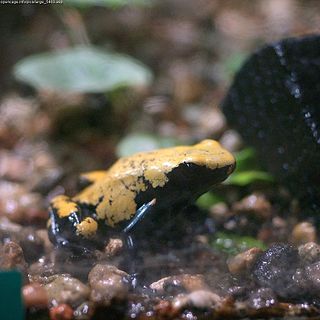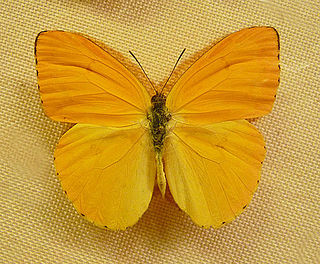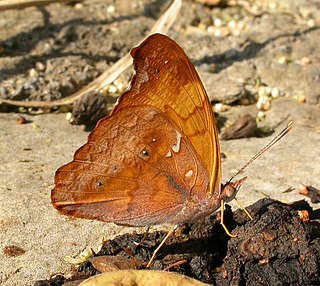
Archaeoprepona demophon, the one-spotted prepona, banded king shoemaker, or demophon shoemaker is a butterfly belonging to the family Nymphalidae.

Catonephele orites, the orange-banded shoemaker butterfly, is a species of butterfly found throughout the northern coast of South America and into Central America.

Prepona is a genus of Neotropical charaxine butterflies in the family Nymphalidae. They are strong fliers in tropical forests where they feed on fermenting fruits and animal dung. The underside of the wings is pale greyish or brownish, while the upperside is dark with distinct iridescent blue markings. A few species also have orange markings on the upperside of the wings. They are popular among butterfly collectors.

Adelphobates galactonotus is a species of poison dart frog. It is endemic to the rainforest of the southern Amazon Basin in Brazil. Its natural habitats are tropical moist lowland forests. The eggs are laid on the ground, but the tadpoles are carried to temporary pools. Though it remains widespread and locally common, it is threatened by habitat loss and has already disappeared from some localities due to deforestation and flooding caused by dams. The species is relatively common in captivity and regularly bred, but the wild populations are still at risk from illegal collection.

Callicore is a genus of nymphalid butterfly found in the Neotropical realm. This genus, like some related ones, was formerly lumped together as the paraphyletic Catagramma assemblage.

Adelpha is a genus of brush-footed butterflies found from the southern United States and Mexico to South America. They are commonly known as sisters, due to the white markings on their wings, which resemble a nun's habit. This genus is sometimes included with the admiral butterflies (Limenitis).

Catonephele numilia, the blue-frosted banner, blue-frosted Catone, Grecian shoemaker or stoplight Catone, is a butterfly of the family Nymphalidae found in Central and South America.

Marpesia is a butterfly genus in the family Nymphalidae. The species of this genus are found in the Neotropical and Nearctic realms.

Battus belus, the Belus swallowtail is a species of butterfly from the family Papilionidae that is found in Brazil, Colombia, Guatemala, Peru and Venezuela.

Rhabdodryas is a genus of butterflies in the family Pieridae. The only species is the straight-line sulphur.

Phoebis argante, the apricot sulphur or Argante giant sulphur, is a butterfly in the family Pieridae.

Catonephele sabrina is a butterfly of the family Nymphalidae.

Haetera piera, the amber phantom, is a butterfly species from the subfamily Satyrinae in the family Nymphalidae. This species can be found in the Guianas, Brazil, Ecuador, Peru, Bolivia and Venezuela.

Doxocopa agathina, the agathina emperor, is a species of butterfly of the family Nymphalidae. It is found in the Guyanas, northern Brazil, and the Amazon region. It is also called the purple emperor but this name may also refer to the European butterfly Apatura iris.

Eueides isabella, the Isabella's longwing or Isabella's heliconian, is a species of nymphalid butterfly, belonging to the Heliconiinae subfamily.

Temenis is a genus of butterflies in the family Nymphalidae, it consists of three species. It was first described by Jacob Hübner in 1819. Members of the genus Temenis are found throughout Central and South America.




















